Abstract
This paper proposes energy-efficient swarm intelligence (SI)-based approaches for efficient mobile wireless charging in a distributed large-scale wireless sensor network (LS-WSN). This approach considers the use of special multiple mobile elements, which traverse the network for the purpose of energy replenishment. Recent techniques have shown the advantages inherent to the use of a single mobile charger (MC) which periodically visits the network to replenish the sensor-nodes. However, the single MC technique is currently limited and is not feasible for LS-WSN scenarios. Other approaches have overlooked the need to comprehensively discuss some critical tradeoffs associated with mobile wireless charging, which include: (1) determining the efficient coordination and charging strategies for the MCs, and (2) determining the optimal amount of energy available for the MCs, given the overall available network energy. These important tradeoffs are investigated in this study. Thus, this paper aims to investigate some of the critical issues affecting efficient mobile wireless charging for large-scale WSN scenarios; consequently, the network can then be operated without limitations. We first formulate the multiple charger recharge optimization problem (MCROP) and show that it is N-P hard. To solve the complex problem of scheduling multiple MCs in LS-WSN scenarios, we propose the node-partition algorithm based on cluster centroids, which adaptively partitions the whole network into several clusters and regions and distributes an MC to each region. Finally, we provide detailed simulation experiments using SI-based routing protocols. The results show the performance of the proposed scheme in terms of different evaluation metrics, where SI-based techniques are presented as a veritable state-of-the-art approach for improved energy-efficient mobile wireless charging to extend the network operational lifetime. The investigation also reveals the efficacy of the partial charging, over the full charging, strategies of the MCs.
1. Introduction
Recent technological advances have contributed to the pervasiveness of wireless mobile devices. Currently, charging the batteries of these devices are facing critical challenges, since the majority of these devices are battery-powered using electrical wires and power plugs, which limits their operational usage. A battery-powered sensor-node has limitations in its operational usage with a finite node lifetime [1]. Due to the energy limitations of battery-powered mobile devices, a wireless sensor network (WSN) is limited in its operations. To prolong the operational network lifetime, several research efforts have emerged, most of which have been studied in [2,3,4,5,6,7,8,9,10] and highlight the various techniques of prolonging the operational lifetime of the network, including methods of energy provisioning to the sensors. Recent approaches have revealed the advantages inherent in the use of mobile elements over the traditional schemes using static multi-hop routing. For instance, the use of a single mobile charger (MC) which periodically visits the network to replenish the sensor-nodes presents some advantages over the traditional schemes. However, new challenges for energy-efficient wireless charging schemes have emerged, due to the requirements of big sensor-based data systems operating in large-scale network environments containing several thousands of sensor-nodes which are spatially distributed across various geographic areas. Thus, the current approaches exploring a single MC are limited and are not feasible for large-scale network environments. Incidentally, other approaches have overlooked some key tradeoffs and critical issues associated with mobile wireless charging schemes, which include: (1) finding efficient coordination and charging strategies for the MCs, and (2) finding the optimal amount of energy available for the MCs, given the overall available network energy. Thus, this paper aims to investigate these critical issues and important tradeoffs in order to fully harness the potential benefits of wireless mobile charging for large-scale network scenarios, so that the network can be operated without limitations.
In the past years, utilizing mobile agents as wireless MCs (to wirelessly replenish the energy-constrained sensor-nodes) is considered an encouraging solution technique to extend the network operational lifetime. However, efficient wireless power transfer (WPT) is currently facing critical challenges due to the emergence of big sensor-based data systems operating in large-scale wireless sensor network (LS-WSN) environments, which require partitioning the network into several clusters and groups prior to wireless energy transmission. Hence, the current techniques are no longer sustainable for LS-WSN scenarios. The idea of network partitioning (i.e., splitting the network into smaller sizes to further reduce the transmission range) aims to minimize the data/charging request flooding problem often witnessed with multi-hop clustering, to minimize the travelling cost of the MCs (as a result of a high movement energy consumption), and to optimize the energy efficiency of the network. Besides, the proposed approach will curb the unnecessary energy transmission delays inherent in the traditional approach and it will also optimize the WPT efficiency of the MCs. In contrast to other approaches, our approach exploits multiple mobile agents, utilizing swarm intelligence-based techniques for energy provisioning to the sensor-nodes. We also investigate some key tradeoffs, which are critical to efficient wireless energy transmission and are seemingly overlooked by other studies. To ensure and optimize energy-efficient route planning and coordination/charging strategies, the paper proposes swarm intelligence-based techniques for the MCs. This is based on their advantages of having both local and global knowledge of the network environment through the way they conduct their search operations, by employing both exploration and exploitation strategies. These two key components of swarm intelligence algorithms are also known as intensification and diversification [11].
In exploitation, information is obtained locally from the existing problem to provide new solutions that can be better than the current solutions. Here, the process of obtaining information is local and, thus, the information itself is also local. The advantage of this technique is that it can lead to very significant convergence rates. However, its drawback is that it may be stuck in a local optimality. Conversely, in exploration, information is obtained globally because the space can be explored more efficiently to provide more diversified solutions than the current solutions. Thus, the search is essentially on a global scale. The advantage is that it is not likely to be stuck locally, and the global-wise optimality is easily accessible. However, its drawbacks are that it has slow convergence and much of the computational efforts are wasted, since many new solutions can be far from the global optimality [11]. This, therefore, necessitates a final balance for the algorithm to achieve a good performance. However, achieving such a balance is a critical challenge of several algorithms, which resort to optimization techniques. In problem-solving, a common practice is to find an optimal solution within a limited time-interval.
One of the techniques that is being used to prolong the lifetime of a WSN is the energy harvesting (EH) technique [12,13,14,15,16,17,18]. Although the EH technique can be used to extend the lifetime of the network and solve the node energy restriction problem to some extent, it still has many deficiencies, bordering on environmental limitations [1,9]. Hence, its success in prolonging the network lifetime remains limited in its operation, as well as providing a performance bottleneck, owing to its environmental dependence. This is, perhaps, one of the major challenges limiting its large-scale deployment for LS-WSN applications. As such, an energy-constrained sensor-node has several limitations in its operational performance, including its computational capabilities, its sensing reliability, and its communication/transmission range. However, nodes can potentially choose to rely on using super batteries to prolong their operational lifetimes, but this will bring an increase in weight and cost implications as a result of higher power requirements [1]. WPT leverages on these shortcomings to present itself as an alternative source of energy replenishment to the energy-constrained sensor-nodes. The recent breakthrough in WPT technology reveals its high potential to address the fundamental energy requirements of a WSN. Thus, WPT technology is currently being used as a new approach to solve the sensor-node energy problem. This technique has been applied in various networks, including the wireless rechargeable sensor networks (WRSNs), characterized by the presence of multiple sensor-nodes (stationary or mobile nodes) and a few high-energy mobile nodes, called MCs, that exploit the WPT technologies to replenish the sensor-nodes based on some charging request priorities. This technology has been found to be more controllable and stable compared to other sources of sensor-energy replenishments [9].
Research efforts on wireless energy transmission reveals that efficient WPT has been achieved by using technologies, such as magnetic resonant coupling, inductive coupling, and EM radiation [1,10,19,20]. To show the pervasiveness of WPT technologies, it has been demonstrated by a considerable number of companies and several international organizations, capitalizing on WPT ideas, to maximize the use of these technologies. Examples of companies applying WPT ideas include: WiTricity, Ossia, Energous, Proxi, and Powercast [21], as well as the Wireless Power Consortium (WPC), the Power Matters Alliance (PMA), and the Alliance for Wireless Power (A4WP) [22]. These technologies and industries lead the way towards an emerging technology and a new paradigm of energy replenishment for WSNs, namely, the Wireless Rechargeable Sensor Networks (WRSNs), which demonstrate the practical approaches for efficient energy replenishment for sensors via wireless charging techniques. WRSNs are an emerging technology consisting of sensors and wireless mobile chargers (MCs). The technology appears to provide an advanced solution to overcome the challenges of battery limitations and is widely applied in many applications, such as in environmental monitoring/surveillance, fire and explosion monitoring, and the medical field [23].
Inspired by the recent breakthroughs in WPT technologies, this study aims to investigate the challenges of efficient wireless charging (WPT) using swarm intelligence-based approaches. Our contributions to this work can be further highlighted as follows. To improve the MC wireless charging efficiency, we identify some key tradeoffs that are critical to efficient wireless charging, which include: (1) determining the efficient coordination processes and charging strategies for the MCs; (2) determining the optimal amount of energy for the MCs, given the overall available network energy; and (3) determining the best algorithm for node partitioning that minimizes the transmission range of the MCs. To address each of the above tradeoffs, we first formulate the wireless charging problem and show that it is computationally hard. To solve the complex problem of scheduling multiple MCs in LS-WSNs, we propose a node-partition algorithm, based on cluster centroids, that adaptively partitions the entire network into several clusters and regions. We also consider some strategies for efficient wireless charging in WRSNs that efficiently partition the network regions into subregions and assign each subregion to MCs based on some charging-request priorities. We then provide, via simulations, some energy-efficient charging and coordination protocols that operate under three assumptions of the network knowledge level: global network knowledge (GNK), local network knowledge (LNK), and no network knowledge (NNK). These factors need to be considered when devising the efficient coordination and charging strategies of MCs. Our detailed simulation experiments, using three representative SI-based algorithms, show the efficacy of the proposed techniques in terms of the various evaluation metrics.
While we appreciate the interesting research efforts and contributions to the wireless charging problem, especially the scheduling operations of a single MC, we note that these approaches are limited and are currently not feasible for LS-WSN scenarios. In contrast to the most notable approaches, we propose a distributed method of wireless charging which utilizes the local and global network knowledge. Our approach also separates the coordination and charging procedures, unlike other approaches that tend to integrate and couple both processes. The necessity of this separation enables the achievement of an efficient design approach for better charger protocols. Moreover, unlike other methods, our approach exploits special multiple MCs, utilizing SI-based techniques for efficient wireless charging in WRSNs. Our detailed analytical and simulation-based approaches investigate the wireless charging problem in terms of the coordination and charging procedures of MCs, as well as the scheduling operations of the MCs.
The rest of the paper is structured as follows. Section 2 presents some related works on SI-based techniques and wireless charging. Section 3 presents the system architecture and the partitioning algorithm, including a brief description of the charging strategies for MCs. The multiple charger recharge optimization problem (MCROP) is formulated in Section 4. Section 5 presents detailed analysis of the MC coordination and the charging strategies. Section 6 presents simulation results and analyses, while Section 7 concludes the work.
2. Related Works and Comparison
This section presents a review of related works and draws comparisons with the existing studies from two perspectives: the swarm intelligence-based techniques, and the energy provisioning in WRSNs using mobile elements. The section critically examines the proposed approach in comparison to other existing works and related studies.
2.1. Swarm Intelligence (SI)-Based Techniques
SI is a novel field of artificial intelligence, concerned with the study of biological species with self-organized behaviors that can be witnessed in social living beings, including ants, fishes, birds, termites, etc. The Collins Dictionary defines SI as “an artificial-intelligence approach to problem-solving utilizing algorithms based on the self-organized collective behaviors of social insects”. SI algorithms are described as heuristics that target and solve complex problems by imitating the swarm behaviors observed in biological systems [24]. Accordingly, systems relying on SI exhibit many useful characteristics, including self-organization and adaptivity. In [24], the authors presented an approach and the system architecture for the efficient parallelization of the swarm algorithms. The proposed method exploited the space partitioning approach, which assigned the various network regions to different servers. The goal was to show the efficacy of the proposed approach in terms of the high degree of scalability in a wide set of scenarios. The performance of the proposed approach was evaluated using the ant-based spatial clustering and sorting algorithm. The primary concepts of SI protocols are its self-organization, where the protocols are designed to provide solutions to many complex problems [25]. The past years have witnessed the development of several routing protocols for WSNs, based on the principles of SI, and the inspiration of the foraging behaviors of ant and bee colonies [26]. Thus, the authors [26] presented an extensive survey of SI-based routing protocols for WSNs. In [27], the authors presented BeeSwarm, an SI-based energy-efficient hierarchical routing protocol for WSNs. The approach consists of three phases, namely, the set-up phase, the route discovery phase, and the data transmission phase. The robustness of the system lies in the integration of the three phases, which invariably forms the major aspect of the protocol. The authors in [28] presented an SI-based centralized clustering solution for large WSNs and compared to other state-of-the-art algorithms using some evaluation parameters (the scalability, the energy consumption, and the data delivery rate). The result of this comparison showed that the SI-based centralized clustering approach outperformed the other algorithms in terms of the performance metrics. The authors in [29] presented a review of SI algorithms for feature selection, which provides solutions to various optimization problems. The survey gave insight to researchers on the possible design approach for a specific feature selection problem. In [30], authors studied the deployment optimization of an unmanned aerial vehicle (UAV) for the data collection platform of IoT devices and proposed a coding scheme based on the SI algorithm. The focus of this approach was to minimize the energy consumption of the UAV. A comprehensive review can be found in [31,32,33]. However, we note that none of the techniques in the literature have exploited SI-based approaches for energy provisioning to sensor-nodes. Our approach investigates the challenges of efficient mobile wireless charging in distributed LS-WSNs, using SI-based techniques.
2.2. Energy Provisioning Using MCs in WRSNs
Recently, the field of wireless rechargeable sensor networks (WRSNs) has witnessed many significant research efforts using a single MC. In [34], authors relied on Powercast technology to prolong the network lifetime of a WSN by constructing a wireless charging queue built on the greedy algorithm. The charging behavior of the MC is considered greedy, since the MC maintains the continuous charging of a sensor-node for a long time before charging another sensor-node. The authors studied the charging problem and proposed several heuristic algorithms to plan the charging activities for the MC (i.e., to determine the sequence of nodes to be charged and the amount of energy to be delivered to the sensor-nodes). This approach exploited a single MC, a robot which is used to deliver energy to where it is needed. Hence, the authors built a proof-of-concept prototype and conducted experiments to evaluate its feasibility and performance in small-scale networks. In [35,36], the authors proposed a single mobile charging vehicle that periodically visits the network and wirelessly replenishes every sensor-node in the network based on a near-optimal solution. The authors capitalized on the recent breakthrough in wireless energy transfer technology and proposed a scenario where a single mobile charging vehicle periodically visits the network to wirelessly charge each sensor-node. They studied a practical optimization problem, with the aim of maximizing the ratio of the wireless charging vehicle (WCV)’s vacation time over the cycle time, and subsequently, developed a provable near-optimal solution for flow routing, the total cycle time, and the individual charging time at each node. Their numerical results showed that a sensor network operating under their solution could remain operational for a long time. The authors in [37] studied the problem of maximizing the network lifetime of a single MC (subject to the energy capacity of the MC) and designed a heuristic algorithm, called FACT, to address the problem. Their work focused on locating closed charging tours for the MC, as well as designing an energy allocation scheme for the MC in a way that maximized the minimum battery energy of all the sensor-nodes after charging. However, the above techniques exploring a single MC have scalability problems in the way that the techniques are limited in the context of LS-WSNs containing thousands of sensor-nodes. The single-charger technique will not be sustainable for LS-WSN scenarios, since the single MC will require a high amount of movement energy to traverse the whole network and it would have depleted its energy before completing its tour of the network. The implication is that several sensor-nodes will be left energy-hungry, thus leading to high node death rates and, consequently, resulting in a network operational breakdown. This is because a single MC has a limited amount of energy that it can provide, which is not feasible in a highly dense network environment. A single MC may not have enough energy to recharge all the sensor-nodes in a large-scale network scenario on a single tour. On the contrary, the use of multiple MCs will undoubtedly handle this problem and will optimize the energy efficiency of the network.
Based on the scalability problem with a single MC in a LS-WSN scenario, the authors in [38,39] investigated the minimum MC problem (i.e., the number of energy-constrained MCs for rechargeable sensor networks to keep every sensor-node working continuously). The authors in [38] approached the problem firstly by proving its computational hardness and then by proposing the use of approximation algorithms, with proven performance bounds, to address the minimum MCs problem. Conversely, the authors in [39] divided the minimum MCs problem into two N-P hard sub-problems: a Tour Construction Problem (TCP) and a Tour Assignment Problem (TAP). They considered a two-step solution to the problem. The first solution employed a greedy charging scheme to solve the TCP, while the second solution proposed a heuristic algorithm to address the TAP. The authors conducted simulations to evaluate the performance of their solutions. However, their solutions were focused on investigating the minimum MCs problem and their routes taken to recharge their sensor-nodes, which may not significantly improve the network lifetime. Our solution is designed to critically evaluate the issues affecting efficient wireless mobile charging in LS-WSNs to maintain a continuous network operation. Moreover, while their solution is limited to sensor-charging, ours can be exploited for both wireless charging and data collection schemes. The work in [9] proposed the use of two different kinds of vehicles, one for data collection and one for wireless charging. Apart from the problem of scheduling two different types of vehicles to a given network, this technique also incurred an increase in the energy consumption of the network, arising from an increase in the vehicles’ movement energy consumption. Moreover, this technique was not cost effective. On the contrary, our approach can exploit the same mobile elements for both the data collection and the energy provisioning to the sensor-nodes to further minimize energy consumption and the cost of deployments. Owing to the potential hazards caused by a high exposure to EM radiation, the paper [40] gave safety considerations to the use of multiple MCs and proposed a safe charging algorithm for WRSNs. This algorithm was meant to create a balance in the relationship between safe charging and radiation safety. The authors in [41] introduced collaborative mobile charging, whereby MCs can also charge each other (in contrast to our model, where we do not address chargers charging each other).
Most of the works in the literature are advancing the topic but are failing to address the capability of a network infrastructure supporting more than one MC, thus creating scalability problems. Such a capability is crucial regarding extending the operational lifetime of a large-scale sensor network containing thousands of sensor-nodes through exploiting multiple MCs. Others overlooked the need to comprehensively address some critical issues and important tradeoffs affecting efficient wireless mobile charging, as is currently being investigated in this study. Compared to existing approaches, our method employs a distributed approach that exploits SI-based techniques for mobile wireless charging in a large-scale wireless sensor network, utilizing local and global network knowledge. Moreover, the multiple MCs approach will handle the scalability problem arising from the single MC technique, which is characterized by high latency times and high node death rates in LS-WSN scenarios.
3. The Network Model
This section presents the proposed network model. The whole network is composed of uniformly and randomly distributed sensor-nodes in a wireless rechargeable sensing field. The sensor-energy provisioning may involve three steps. Since our approach considers a large-scale network environment, the first step will be to partition the network size into smaller sizes using the MCs. The second step is to select a suitable starting point for the MCs (i.e., envisioning the movement trajectory of the MCs). If the MCs decide to start from the same location in the last region after splitting the network, it is good to optimize the MC’s movement-energy consumption by locating a suitable starting point in every region.
3.1. Network Elements
Sensor data is generated at normal nodes and is aggregated at cluster heads (CHs) in a multi-hop fashion. Figure 1 shows a clear description of the entire network. Since the network is partitioned into multiple clusters inside a particular region, it is appropriate to have some cluster heads (CHs). Here, CHs are sensor-nodes that collect data packets from other nodes and transmit them to the MCs (here, the MCs are also the DCs). Hence, the rechargeable sensor-nodes consist of the normal nodes and CHs. Other nodes can forward their data to CHs using a multi-hop routing mechanism. The base station can be sited at the central position of the network, and it can be used for the data processing and recharging of the MCs to maintain continuous network operations. Finally, we will determine the CHs and the shortest moving distance of the MCs in each small region. The MCs (also serving as DCs) stay at the CHs in each region and collect the data aggregated by the CHs, while also replenishing the energy of the sensors within that vicinity. Moreover, the selection of the CHs is dynamic, as every region reselects the CH to avoid/minimize the hotspot problem and the data request flooding problem for multi-hop clustering. Then, the geometric traveling salesman problem (G-TSP) path of the MCs is structured to minimize the total traveling cost, the movement-energy consumption, and the data collection delays. The MCs can serve as both energy transmitters and data collectors. While traversing the network, the MCs collect the aggregated data from the CHs and recharge the sensor-nodes located within the vicinity of the CHs. Collected data are subsequently uploaded to the base station or the big data collection center. We propose a point-to-point charging of the sensor-nodes based on charging request priorities. Once an MC uses up its energy to charge the sensors, it quickly returns to the base station for energy replenishment.
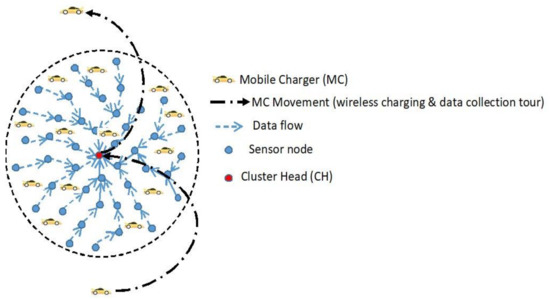
Figure 1.
Network model and components.
A detailed list of notations and their descriptions are presented in Table 1.

Table 1.
Notations with their descriptions.
3.2. The Deployment and Energy Model
Three kinds of devices can be identified with the proposed scheme, namely, the static sensors, the mobile chargers (MCs), and the static sink, as shown in Figure 2. Our model assumes that there are 𝓝 sensors of the wireless communication distance ɖ randomly distributed in a circular sensing field with the area ⍲ and the radius (we investigate both uniform and non-uniform distributions) and n MCs are initially deployed at the center of a circular area along the x-y coordinates in Equation (1):
where p = {1, 2, … n}. If we assume that the 𝓝 sensors are uniformly and randomly distributed in a circular area of the radius , then the network density is given by:
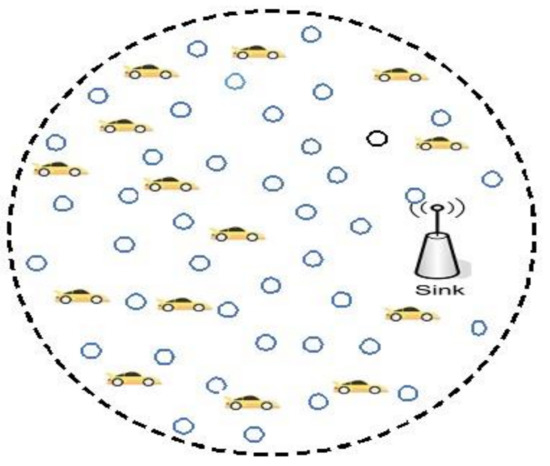
Figure 2.
The network architecture.
The communication range of the sensors varies according to requirements of the underlying routing protocols. Because the algorithms can run for an extended time with only one initialization, the initial position of the MCs may not be important as it could also be located at the center of the network. The base station or sink can lie anywhere in the network and is used to replenish the MCs and aggregate data from the MCs. This model relies on both wireless power transfer and data collection. For simplicity, we assume that all sensors can generate data packets at the same rate of δ per unit of time. This assumption is typical of the monitoring and reporting applications in a WSN. If we denote as the total available energy in the network, then initially,
where is the amount of energy distributed among the sensor-nodes and is the total energy initially possessed by the MCs that can be delivered to the network to charge the sensors. Each sensor and each MC, respectively, have a maximum amount of energy representing their initial energy, given as:
For message transmission and reception, our model assumes that the amount of energy dissipated by the radio module is proportional to the message size. For a ɤ-bit transmitted message, the radio expends and to receive the ɤ-bit message. It expends where and are constants which depend on the transmission range ɖ of the sensors and the radio module. Generally, the power needed for transmitting a message at a distance ɖ is roughly where is a constant; for simplicity, we take .
Uniform and Non-Uniform Deployment
We investigate both cases of uniform and non-uniform deployments of the 𝓝 sensor-nodes in the network. We show, in Figure 3, a network that is virtually partitioned into slices and co-centric rings of small sectors. We define a sector as the intersection between a slice and a ring. Figure 3a shows that there are 8 slices (, while Figure 3b shows the different partitions of the slice sectors. Here, each slice contains 5 sectors, thus giving a total of 40 sectors in the network. We assume a case of random non-uniform deployment of the sensor-nodes. Let represent the sector corresponding to the intersection between a slice m and a ring n as shown in Figure 3b and let denote an arbitrary constant. Let denote the relative density of the sector selected independently along based on a uniform distribution where We note that the values of tend to 1 for a low relative density and tend to k for a high relative density. By putting together the knowledge about the total number of sensors in the network 𝓝 with the relative density and the area of every sector, we obtain the number of nodes using the relation:
where . Then, nodes are distributed in the area corresponding to sector . The fraction of the actual densities of the two sectors and is exactly . In addition, this model considers a uniform deployment, where all sectors have the same relative density (i.e., for all ).
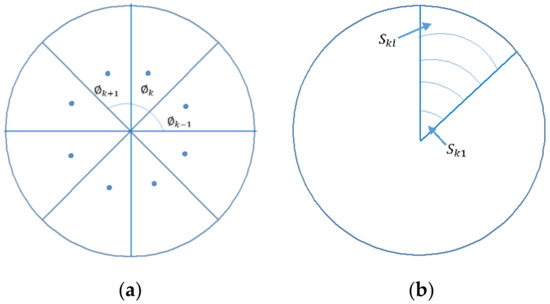
Figure 3.
Partitioning the network into slices and sectors. (a) Slices. (b) Sectors.
3.3. Recharge by Adaptive Network Partitioning and Clustering
In order to effectively cover the wide geographical regions of the whole network, multiple MCs are employed to charge the sensor-nodes and to collect data. To solve the complex problem of scheduling multiple MCs in LS-WSNs, we propose to adaptively partition the whole network into several clusters and distribute an MC in each region. Some advantages of a distributed clustering approach in real-world scenarios are provided in [42], which include improving the route connection, minimizing the energy consumption, and increasing the scalability while reducing the traffic. To calculate the minimum number of MCs needed to achieve perpetual network operation, we use Equation (6) [43]. That is,
where denotes the number of MCs, is the inverse cumulative distribution function of normal distribution, is a value approaching 1 but is not equal to 1, T is a large time frame, is the total energy consumption of the network up to T, is the initial energy of the sensor-nodes, L is the length of the sensor field, v is the speed of the MCs, is the recharge time of the sensor-node’s battery, and is battery capacity of the sensor-nodes. The probability for the energy-neutral condition [43] is modelled as:
where is the total energy replenished into the network by the MCs, up to T. Since , the network operation is considered perpetual at a high probability of occurrence of , if but is not equal to 1, e.g., . Though the rate of data generation is dynamic, the process can be modeled as a Poisson process to determine the number of MCs. Since the number of MCs in the network is known, the number of network partitions ¢ can get through ¢ = . Hence, each sub-region of the network always has MCs to ensure wireless energy transfer and data collection. The process of network partitioning and clustering is as follows:
- The first partition is conducted. This method is like that in [9] and follows a uniform division of the network into c parts. Unlike [9], our method uses a dynamic selection of the cluster centroids, where CHs can be in each region of the network. These nodes are located at the center of each region. Besides, we evaluate the distance and the shortest hop routing from each node to the cluster centroids. denotes the distance between node j and cluster centroid k, where .
- The second partition is conducted. Firstly, we evaluate the weight of each node j to k. Here, ; . We define and as part of the distance and routing hop priorities, respectively, and is the serial number of the distance from node j to cluster centroid k. If denotes the minimum value of , denotes the maximum distance We denote as the ratio of and . If , our algorithm only considers a routing hop. On the contrary, our algorithm can also consider distance when . In this case, we jointly consider the routing hop and distance to make . Next, the smallest is chosen, owing to its partitioning, and the node j is assigned to the kth region. This whole process is repeated until all the nodes in the network are partitioned. The proposed network partitioning and clustering method can be summarized in Algorithm 1.
| Algorithm 1: Node-partition algorithm based on cluster centroids. |
| Let S sensor-nodes and c cluster centroids be inputted We denote the output as: min Calculate distance and the shortest hop between node j and centroid k where . Arrange and in ascending order denotes the distance of the serial number and is the routing hop serial number of node j to centroid k. While Calculate , the node j is assigned to the kth region. End |
In addition, computing the distance and the routing hop for every node requires at least . Every node has a sorting time complexity equal to [9]. Since there are S sensor-nodes, we would need . Lastly, to calculate and the least value in , we need the time complexity and , respectively. Hence, the overall complexity of this algorithm is .
Figure 4 shows the results of the network partition. The red dotted lines equally partition the network into four parts, Q, R, S, and T. This represents the first division. Besides, the red points indicate the cluster heads (CHs) of every region, which also indicate the initial points of each region. Then, a second partition is run based on these CHs. We obtain the same shape of the cluster with the nodes belonging to a partition after operating a partition algorithm. The blue dotted circle represents the result of the second partition. Obviously, some nodes previously belonging to areas Q, R, S, and T are now assigned to the U region, as a result of the second partition. The final partition occurs when all the nodes in the network have been assigned to a particular cluster, having a CH in that region.
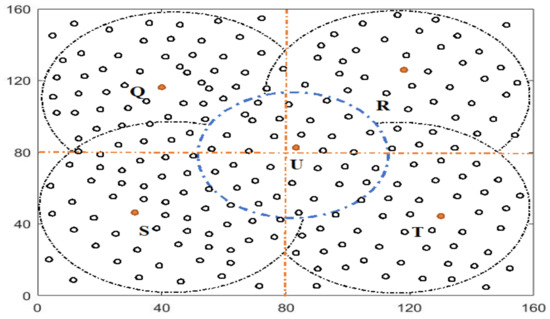
Figure 4.
Network partition based on clustering.
3.4. Charging Model and Strategy for MCs
Our model considers point-to-point charging. That is, each sensor-node is charged by an MC at a time when the MC approaches it at a very close range to optimize the charging efficiency. The movement time of the MC to visit each of the sensor-nodes is considered negligible compared to the charging time; nonetheless, the trajectory of the MC is particularly of interest to us, since it may incur some sizeable and reasonable cost implications. We assume that the charging time is equal for all the sensors and is independent of their battery status. Compared to other works, which integrate and couple both phases, our charging model is split into two phases: the coordination phase, and the charging phase. These two phases are discussed in detail under Section 5.
One of the objectives of this study is to investigate efficient coordination procedures and charging strategies for the MCs. This will help to avoid/minimize some charging conflicts among the sensor-nodes. We note that charging conflicts may arise in a situation, such as when a charging request from a sensor-node to an MC causes a sudden rise in the RF exposure of the networks above the safety threshold because another MC is already responding to an energy request from another sensor by radiating its energy to the sensor. Again, in the absence of proper coordination among several multiple MCs and receivers, a malicious energy receiver, which is fully charged, may prevent other energy receivers from being replenished by reporting a high RF value above the threshold and, subsequently, prompting energy transmitters to switch off their power transceivers or significantly minimize their rate of power transmission and, consequently, deprive many neighboring nodes of energy replenishment. Because power transmitters always expect requests and feedback from the receivers, a malicious energy receiver can purposely inject malicious feedback to undermine the general transmission efficiency. A situation may also arise where greedy and cheating energy receivers become the largest beneficiaries by continuously sending charging requests to the power transmitters, with the intention of starving other neighboring receivers of energy replenishment. This becomes more problematic in cases where the MCs are equipped with directional antennas.
4. Recharge Optimization Problem with Multiple Mobile Chargers (ROPMMCs)
This section presents our multiple charger recharge optimization problem (MCROP) and considers some practical challenges for real sensing applications. The first challenge is the palpable increase in MC’s ‘movement energy’ consumption, due to the improper coordination procedures for energy provisioning to the sensors. The ‘movement energy’ of the MC is the amount of energy spent in traversing the network to recharge the sensors. In this instance, the trajectories of the MCs should be of paramount importance to minimize the movement energy consumption and travelling costs. Thus, the recharge route should be carefully structured to reflect the MC’s current energy position and traveling costs. The second constraint has to do with the non-uniformity in energy consumption occasioned by data transmissions. We note that some nodes assume higher energy consumption rates than others and should be given higher priority recharge-request considerations (i.e., they should be allocated a higher recharge frequency) to maintain the network’s functionality. This is particularly the case with nodes close to the CHs with higher data transmission activities compared to other nodes. We adopted an adaptive recharge threshold, which is proportional to the energy consumption rates at various cluster-regions. Hence, nodes close to the CHs are given a higher charging frequency than others. The recharge routes also take into consideration all the concerns stated earlier.
Next, we formulate the wireless recharging problem as a multiple charger recharge optimization problem (MCROP) and show that it is -complete from the geometric traveling salesman problem (G-TSP). Our aim is to minimize the MCs’ total cost of traveling when they traverse the network to charge the sensors. The TSP with profits [44] presents a reward by visiting a city with the aim of maximizing profits. The reward, in our problem, denotes the amount of replenishable energy by a sensor-node, while the cost is a measurement of the energy cost used to traverse the entire network.
The MCROP can be formulated as follows:
MCROP: Given a set of MCs, M = {1, 2, … m}, and a set of rechargeable sensor-nodes, Sr = {1, 2, … sr}, where each sensor-node is capable of storing E units of energy for each in a list Ls of pairs , where represents the time taken to generate the message of , and is the energy expended by the sensor-node in its message transmission. We consider a graph, G = (U, V), where is the location of the sensor-nodes j to be visited, and V is the set of edges. Each edge has a traveling energy cost which varies directly with the distance between the nodes j and k, and a latency cost , where is the recharge time of node j from its current energy status to its full capacity, and is the traveling time from node j to node k. The recharge capacity of an MC is used to determine the maximum number of sensor-nodes to be recharged before the MC’s energy is depleted. We note that different MCs could have varying recharge capacities during the run. We also consider an matrix R, where is the distance between sensors j and k and an MC, M, which can recharge a sensor-node to its initial energy in a timely manner. If we assume that the MC moves at a constant speed v, then the time of travel between j and k can be calculated as . The MCROP is to determine the feasibility of scheduling an MC for node-energy replenishment to minimize/avoid packet loss arising from insufficient energy.
We adapt the method in [22] to prove that MCROP is -complete. If we consider a certain walk of the mobile charger (MC) when it visits the sensors in , we can validate whether this walk is sufficient enough to avoid packet loss, i.e., no data packet y is generated on a sensor-node such that y denotes the message of and has less than available energy at time . This can particularly occur in time, where is the sum of events generated in the network. Hence, MCROP . To complete the proof and show that MCROP is -hard, we use the G-TSP (see [45], pg. 212). If and 𝔸 ϵ 𝕌 are the inputs of G-TSP, then this can be transformed into an input for MCROP, as follows. We use a set of sensors and equal to the Euclidean distance between the th and kth points in Q. Moreover, each sensor has a list of events defined by where v denotes the MC’s speed. This implies that each sensor has two event-occurrences. The event at time 0 depletes all the available energy in and the other at requires energy 1. A solution to this MCROP problem gives an answer to G-TSP, implying that G-TSP ≤ MCROP.
5. MCs Coordination and Charging Traversal Strategies
In Section 4, we showed that the problem is hard to solve, even with the global knowledge of the energy dissipation. The heuristics presented face a more difficult problem, since the knowledge is restricted to a local level. In contrast to other known approaches, we have split the MC’s charging traversal strategies into two phases, namely, the coordination and the charging phases. This splitting will give us room to focus on each aspect more precisely. To thoroughly understand and examine the MC’s coordination and charging process, we first analyze some of its characteristics and inherent trade-offs.
5.1. Percentage of Energy Available to the MCs
An important tradeoff to be investigated is the optimal amount of energy for the MCs, with respect to the overall network energy, . In order to maintain an open-mindedness, we assume that the total available network energy is finite and remains the same for all cases. This will help to investigate any increase in the energy efficiency (and to what extent) with respect to the presence of the MCs in the network and the charging process. This specific tradeoff defines how much energy (with respect to the total available energy) should be initially provided to the MC. It may appear that increasing the energy of the MC will result in a better energy management in the network. However, this idea is contradicted by Equation (3), i.e., . If we assume that the total energy available to the network, , remains the same, then any increase in the energy of the MCs implies that the sensor-nodes will not be fully charged (i.e., will initially receive partial charging) and will, most likely, run out of energy shortly before being charged by the MC, thus leading to a possible operational network breakdown. We investigate the optimal amount of energy available to MCs as a percentage of , by selecting the initial energy of the MC to be 20, 40, 60, and 80% of the total energy of the network for the various ratios of and . Figure 5 shows the result of this investigation. From this result, it is evident that above 40% of the total energy provision to the MC will negatively affect the operations of the network. This result is predicated on two factors. Firstly, from Equation (3) above, an increase in the energy of the MC minimizes the initial energy of the nodes, thus leading to a quicker node death rate. Secondly, increasing the energy of the MC to a high amount may reduce the MC’s rate of energy distribution in the entire network, resulting in an increase in the residual energy at the MC when the network is disconnected.
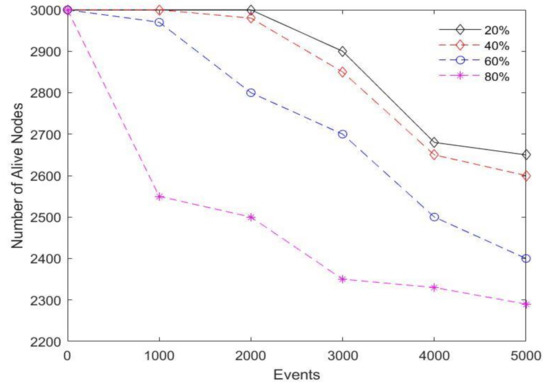
Figure 5.
Number of alive nodes over time for different MC initial energy percentages.
A major conclusion shows that using a moderate percentage of energy at the MC is correct, such as the arbitrary value of 20%.
5.2. Partial vs. Full Charging
One straightforward strategy about the MC’s visit to a sensor-node would be to fully charge the node. By so doing, the MC would have maximized the time interval of revisiting the sensor-node before its energy is depleted. However, the operations of the network are such that energy is dissipated at the sensor-nodes for data transmissions and at the MC for charging activities, thus making it difficult for the MC to deliver energy to more and more sensor-nodes, since the MC will have increasingly less energy to distribute.
Another strategy would be for the MC to judiciously distribute its available energy to as many sensor-nodes as possible to prolong the network lifetime. With this rationale, the amount of energy that the MC can deliver to a node j is proportional to the residual charging energy of the MC. Simply put, the MC charges a node until its energy becomes
To determine the best charging strategy of the MC and the energy that it transmits to the sensor-nodes, we adapt the MC charging model and strategy in [22,46], where the full charging strategy is compared against our adaptive partial charging strategy. The model in [46] used Friis’ free space propagation model to compute the charging efficiency of the nodes according to Equation (9):
where are the uth charging points of the MCs, (transmit gain), (receive gain), is the wavelength, is the polarization loss, is the rectifier efficiency, is an adjustable parameter that adjusts Friis’ free space equation for short distance transmissions, is the transmit power, is the distance between node j and the MC, and is the charging radius of the MC. If , Equation (9) is transformed [46] as:
where .
The energy of the sensor-node, after being charged by the MC, is given in Equation (11) [47]:
where is the residual energy of the sensor-node j before charging, is the charging time of the MC, represents the energy received by node j from the MC, and is the maximum storage energy threshold of the sensors.
Here, we randomly select 40% of as the initial energy of the MC. The results are shown in Figure 6. The basic result obtained shows that our partial charging strategy is efficient compared to a full charging strategy. Our partial charging scheme outperforms its full charging counterpart after a given number of generated events. The outcome of this investigation reveals the fact that the MC expends more energy on sensor recharging when applying the full charging method. Hence, much of the MC’s energy is consumed quicker, leading to a rise in the node death rate.
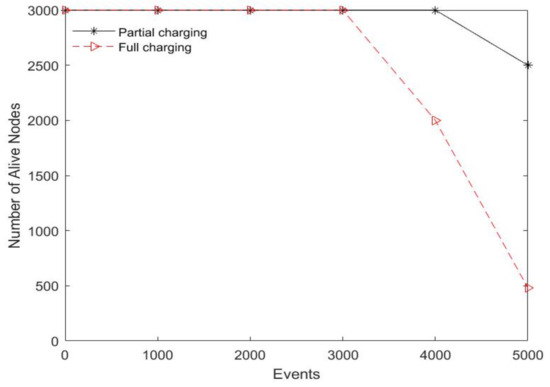
Figure 6.
Number of alive nodes for full and partial charging with 40% of total energy.
5.3. Coordination Strategy
As MCs traverse the network to replenish the sensor-nodes, their own energy is also consumed. The rate of their energy consumption may vary, owing to the non-uniform rate of events generation. Hence, some MCs may be more burdened than others. For this reason, it is necessary for the MCs to periodically communicate with themselves for the proper coordination in their charging process to optimize energy efficiencies and their associated costs. For example, a weaker MC, in terms of energy, may be assigned to a smaller network area. The coordination strategy of MCs can be achieved either through a centralized or distributed approach. In the distributed approach, an MC is informed about the energy position of its neighboring chargers, leading to a more secluded coordination between neighboring chargers. The centralized approach is performed using information from all n MCs. For centralized coordination, we assume that the computations are performed by a computationally strong network entity, such as the sink. Generally, centralized coordination is seen to be powerful compared to distributed coordination. Hence, the performance of their protocols serves an upper bound on which their distributed counterparts are compared to.
- Distributed coordination: Here, the MCs perform distributed coordination among themselves and assume limited network knowledge. The network area is split into slices as shown in Figure 3a, and each slice is assigned to an MC. Each MC can adjust their slice limits to suit their region of interest, either by increasing or shrinking the slice. The MCs, in a distributive manner, define their slice limits in accordance with the size of the region of interest. Hence, an MC with a lower energy status provides its neighbor with a portion of its region of interest for charging. Besides, the energy levels of the MCs determine which of them should reduce their region of interest. Figure 7 shows the distributed form of coordination. Specifically, Figure 7a–c depicts distributed coordination before, during, and after the coordination, respectively.
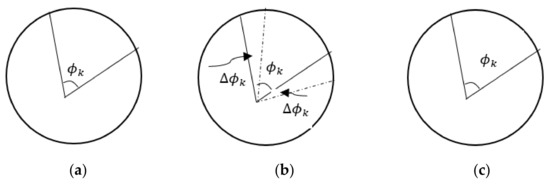 Figure 7. MC distributed coordination. (a) Before the coordination, (b) during the coordination, (c) after the coordination.
Figure 7. MC distributed coordination. (a) Before the coordination, (b) during the coordination, (c) after the coordination. - Centralized coordination: We can distinguish two kinds of centralized coordination. (a) The MCs assume local network knowledge (LNK), and (b) the MCs assume global network knowledge (GNK). In (a), the coordination process uses information from all MCs, including their energy status and position. Essentially, each MC is assigned to a network region. Using Equation (1), the initial deployment coordinates are where p = {1, 2, … n}. The network area is split into slices, as shown in Figure 3a (e.g., for n = 8 chargers) with one MC assigned to each slice. During the initialization of the coordination process, we calculate the region of each MC. An MC is assigned to a regional area equivalent to its present energy status to balance the energy dissipation among the MCs. To calculate the regional area of an MC k we compute the central angle corresponding to the slice of the MC. That is, , where . In the case of global knowledge, the MCs assume global network knowledge and obtain the most updated energy information from sensors, which they use to make real-time decisions. The energy information is aggregated by CHs (special nodes in the network acting as representatives of the partitioned network areas). The MCs communicate with each other to update their energy status and positions. To avoid charging conflicts (already discussed in Section 3.4) where MCs select the same node for charging, the sink can be used to store and update each node’s availability, as well as prioritizing their charging requests. This can be done by maintaining a 0–1 node list wherein a node is assigned a value of 1 (locked) when selected for charging and is returned to a value of 0 after being charged. Using this method, an MC can simply communicate with the sink, ignore nodes that have already been chosen by other MCs, and inform the sink of the energy status of the node it has selected. The global knowledge coordination strategy is expected to outperform all other strategies exploiting local knowledge, since the assumption of global network knowledge further extends the MC’s coordinating abilities. However, this strategy would be unrealistic and would not be feasible for real LS-WSNs, as it introduces a high communication overhead whereby every node has to propagate their energy status to the MC, and nodes and MCs have to communicate their status over large distances. This does not scale well with LS-WSNs. Thus, the global knowledge charger studied presents an online solution that minimizes, in each round, the product of each node’s energy and its distance from the present position of the MC. Simply put, for each moving step, the global charger reduces the following [22]: where , , and are the current energy, initial energy, and current transmission distances of each sensor, respectively.
5.4. The Charging Traversal Strategy
Here, the MC traverses the network area it is assigned to and charges the sensors in that region. Studies on charging traversal strategies are currently limited to a single mobile charger (MC). In our approach, we have extended this to multiple MCs and have also given special attention to the amount of knowledge possessed by the MCs, in terms of its region. Hence, to suitably design the MC’s charging traversal strategy, we distinguish the MC’s amount of knowledge under the following three major characteristics: no network knowledge (NNK), local network knowledge (LNK), and global network knowledge (GNK).
In the case of NNK, the MC is assumed to be ‘blind’ and, thus, is limited in using sophisticated charging methods. The trajectory of the MC is also restricted to several naïve options, presented in [22]. Our approach uses the ‘blind’ scanning of the network area, where the MC begins its tour from the sink and traverses an exhaustive route until it reaches the boundaries of the network region. The advantage of this movement is that the MC tours the entire network to charge almost all the nodes until its energy is completely depleted. However, owing to lack of knowledge, this movement is not adaptive.
In terms of LNK, the MC operates with a local network assumption. The slice relating to charger k is divided into l sectors of the same width, as shown in Figure 3b. The sectors in charger k are prioritized based on the high number of sensors with a low residual energy status. We adapt the theoretical model in [10] for the charging process. Let represent the lowest residual energy level of a sensor-node in the sector . Let represent an energy level close to , then .
Let denote the number of sensors in Sector with residual energy between and , then where is the number sensors with the energy level e. The MC k charges the sector and maximizes the process in the form of . The motive behind this charging process is to group many sensor-nodes according to slices (sectors) and to select a particular group based on their energy requirements. The group that requires more energy than the others is first selected for charging.
The GNK charging strategy considered in our model is impacted by two important metrics, energy and distance. These two factors have equal weight, and one is not more dominant than the other. The MC calculates the product of these two metrics for every node in their cluster and chooses to charge the node with the minimized product. For each phase, the MC moves to a sensor in the cluster in a way that reduces the product of each sensor’s energy and the distance from the MC. Specifically, the MC charges the node where is the residual energy of the sensor j. In other words, the charging strategy is prioritized among nodes with a low residual energy and a minimum distance from the MC.
The analytical studies conducted in this section enable us to investigate the traveling distance of the MCs operating under the three scenarios that have already been discussed. Essentially, the traveling distance of the MCs is an indirect reflection of the coordination process and the charging strategy. The traveling distance also has an impact on the relevant movement cost. Figure 8 and Figure 9 depict the results for both uniform and non-uniform cases of node deployment. The results show the total distance travelled by three MCs exploring the three scenarios (GNK, LNK, and NNK) for both uniform and non-uniform deployments. It is very clear that the MCs operating under GNK and LNK achieve the required charging strategy by traveling less distance than NNK. As seen in both Figures, MCs exploring the NNK scenario travel a longer distance, compared to MCs exploring LNK and GNK. The MCs also achieve a balanced distribution of the traveled distance, unlike when the chargers operate under NNK. In Figure 9, the total distance covered by all MCs is higher compared to that in Figure 8. This implies that in non-uniform deployment, MCs travel much longer distances than in the uniform case. This presents a more realistic scenario that occurs in real-life large-scale sensor networks. Nonetheless, the distribution of the total distance covered for both cases are similar. Generally, a non-uniform node deployment incurs a much longer distance (and, by extension, a higher movement energy consumption) than in the uniform case.
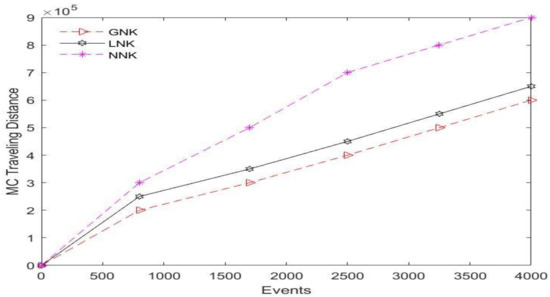
Figure 8.
Distance travelled by MCs for uniform deployment.

Figure 9.
Distance travelled by MCs for non-uniform deployment.
5.5. The MC’s Movement Energy and Charging Costs
The movement energy cost of an MC is the amount of energy expended by the MC for its movement in order to charge the sensor-nodes within the network region. We assume that MCs have only one energy bank used for both the movement and charging of sensors. On the other hand, the charging cost of the MCs is the amount of energy used to charge the sensors. This paper assumes no energy losses during the charging process. Hence, the charging cost equals the beneficial energy cost (i.e., the energy received by the sensors). The paper also does not consider the amount of energy spent for movement, but it has computed the amount of distance traveled by each MC, which provides some estimate of the cost. More precisely, we have applied similar assumptions for the MCs as in [36,48], as well as the battery calculator in [49], and have provided, in Figure 10, an estimate of the MCs’ movement energy spent in traversing the network for its uniform node deployment. It is observed that MCs exploring the NNK spend a high amount of energy in movement. On the other hand, MCs exploring LNK and GNK, to minimize their traveling distance, also minimize their movement energy costs.
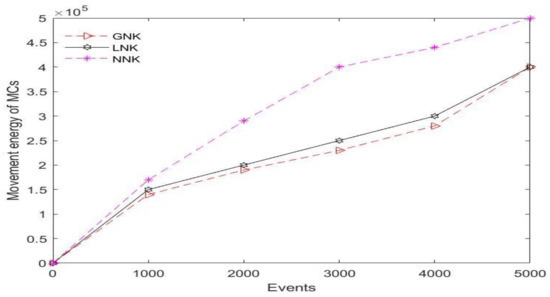
Figure 10.
Movement energy of MCs over time.
6. Simulation Results and Analysis
The proposed approach is simulated in the MATLAB environment using RMASE, an application framework that runs under PROWLER. The simulator is an event driven WSN simulator which makes use of codes that are compatible with MATLAB codes and, thus, is run in a MATLAB environment. RMASE has well-defined metrics whose values are generated as the simulation is being run. Our experiment considers three swarm intelligence-based routing protocols, IEEABR [50,51] BeeSensor [52,53], and FF [51,54], which are compared using evaluation metrics. For the network model under consideration, we place the sink at the center (m, n) = (0, 0) of the circular network with 1000 to approximately 4000 sensor-nodes and two to approximately six MCs. The following evaluation metrics are considered, and the results are shown in Figure 11, Figure 12, Figure 13, Figure 14, Figure 15, Figure 16 and Figure 17. Overall, the IEEABR, which is an energy-efficient swarm intelligence-based routing protocol, outperformed other protocols in terms of the evaluation metrics. The reason for the high performance of the IEEABR, compared to other routing protocols, is attributed to its ability to easily converge dynamically to achieve an increased packet delivery ratio.
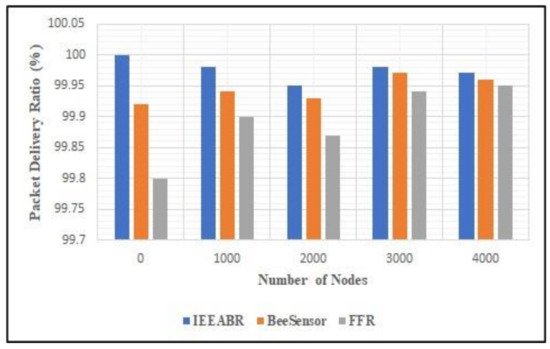
Figure 11.
Packet delivery ratio.
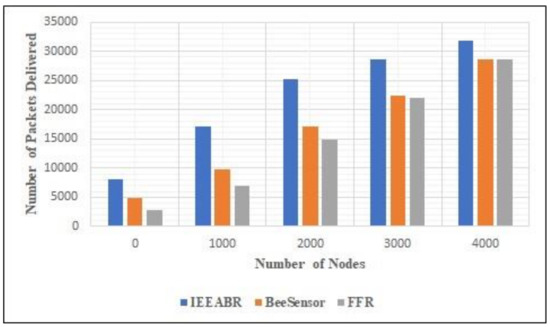
Figure 12.
Total packets delivered.
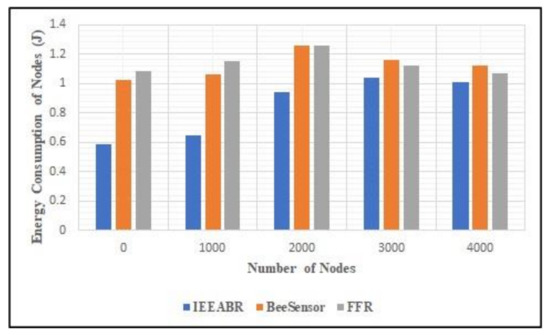
Figure 13.
Energy consumption of sensor-nodes.
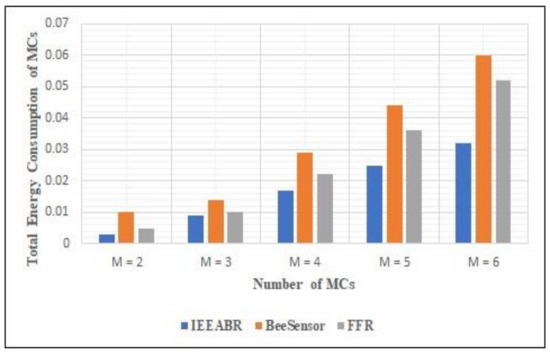
Figure 14.
Total energy consumption of MCs.
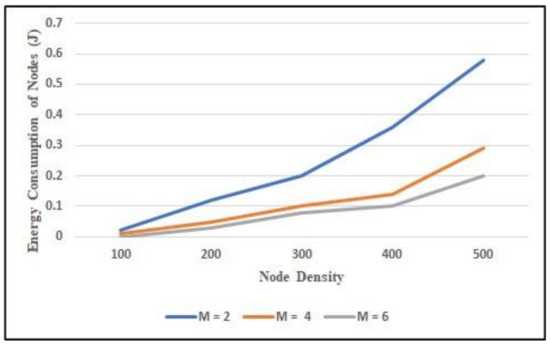
Figure 15.
Effect of number of MCs on the total energy consumption of nodes.
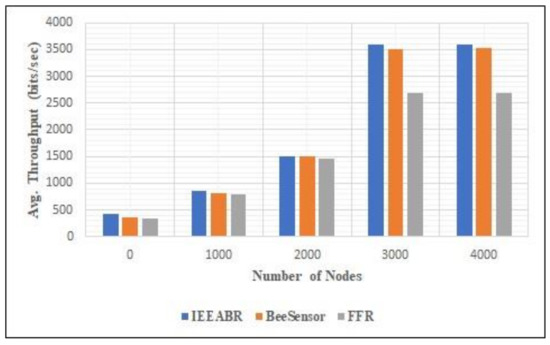
Figure 16.
Average throughput.
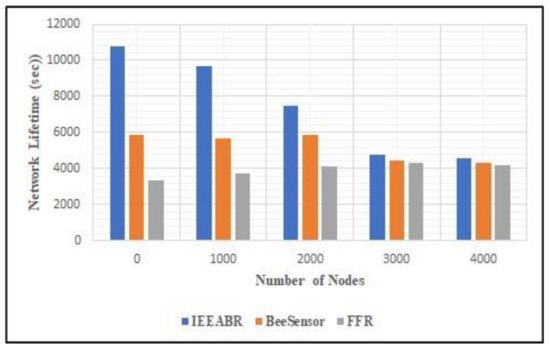
Figure 17.
Network lifetime.
6.1. The Packet Delivery Ratio (PDR) and the Total Packets Delivered
The PDR is defined as the ratio of the total transmitted and received packets. The total number of packets delivered at the sink node may be lower than, or equal to, those generated at the sensor-nodes in the network. Figure 11 shows the results of the PDR, showing the high performance of the IEEABR over other SI-based protocols. Initially, at a very minimal node density, the IEEABR performed optimally by delivering 100% of all the generated packets in the network to the sink node via the MCs, which double as mobile data collectors. This is followed by the BeeSensor, which achieved a 99.91% PDR, and then FFR, with a 99.8% PDR. As the node density gradually increased, the PDR for the IEABR still remained high compared to the other protocols. Even up to the highest node density of 4000 sensor-nodes, the IEEABR still maintained a high PDR of 99.96% and is also rated as high compared to the BeeSensor and the FFR. Figure 12 shows the total packets delivered by each of the routing protocols (which shows the actual number of packets transmitted to the sink from different sensor-nodes). The IEEABR achieved the highest PDR compared to the BeeSensor and the FFR, even at a maximum node density. This achievement is significant and critical for surveillance/monitoring and target-tracking applications in large-scale wireless sensor network environments.
6.2. The Energy Consumption of the Sensor-Nodes and MCs
The energy consumption of the sensor-nodes denotes the total energy expended by all the sensor-nodes in the network in the data transmission to the MCs and/or to the sink. Generally, energy consumption refers to the average energy utilized by the sensor-nodes in the network for a given simulation round. Conversely, the energy consumption of the MCs refers to the average energy spent by all the MCs in the network in recharging the sensor-nodes and/or transmitting their data packets to the sink. Figure 13 and Figure 14 show the energy consumption of the sensor-nodes and that of the MCs, respectively. In both figures, the IEEABR outperformed other routing protocols and consumed the least amount of energy compared to the BeeSensor and the FFR, even at a high node density. In Figure 14, the average energy consumption of the MCs is evaluated using various node distributions and a number of MCs. Increasing the number of MCs results in an increase in the total energy consumption. However, as clearly observed, the distribution of nodes does not have impact on the energy consumption of the MCs.
In Figure 15, we show the effect of the number of MCs on the total energy consumed by the sensor-nodes. As can be seen, the energy consumed by h sensor-nodes is reduced by increasing the number of MCs. This is because an increase in the number of MCs in the network further minimizes the transmission/communication range of the sensor-nodes and, consequently, their energy consumption.
6.3. Throughput
This is the overall number of packets delivered at the sink within a second. This is measured in data packets per second (Kbits/sec). Figure 16 shows the performance of the routing protocols in terms of throughput. Again, the IEEABR outperformed the other routing protocols. At 2000 nodes, the three protocols almost achieved an equal performance. However, the BeeSensor and the FFR protocols lagged behind the IEEABR as the number of nodes increased (i.e., high node density).
6.4. Network Lifetime
This is the extended lifetime of the network for different rounds at a particular time. Figure 17 shows the network operational lifetime prediction of the routing protocols. As can be seen, the IEEABR outperformed other routing protocols by showing the highest lifetime. The network is evaluated by considering the number of rounds until the first node has utilized all its energy. The purpose of this evaluation is to show the improvement and efficacy of SI-based techniques in saving energy and prolonging the network lifetime. The results show that the IEEABR achieved the longest network lifetime, followed by the BeeSensor and then by the FFR, thus making the IEEABR suitable for target tracking application scenarios. Unlike other existing schemes, SI-based techniques employing multiple MCs lead to a reduction in the transmission range of sensor-nodes, as well as their energy consumption, thereby resulting in an improved network lifetime. The figure further shows the ability of the IEEABR to support almost 50% of the additional rounds at the first stage of the network. The maximum support strength is reached as the node density increases.
Figure 18 shows the charging time of the MCs per unit cycle with different numbers of sensor-nodes. As shown, the IEEABR outperformed the other routing protocols. In general, the result shows the efficacy of SI-based techniques for wireless mobile charging in a dense sensor network environment. The BeeSensor is observed to have the highest charging time among the protocols. This performance may be attributed to its reactive method of route discovery, which tries to recalculate routes each time there is a need for packet transmission to the sink node. This, invariably, creates delays and, consequently, high charging times.
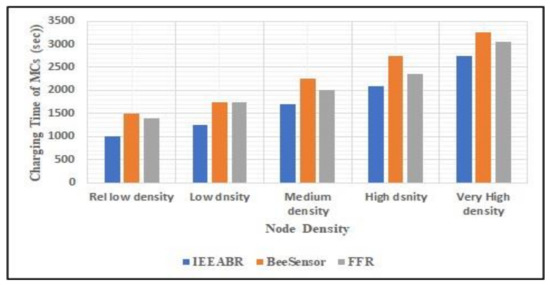
Figure 18.
Charging time of MCs during a cycle.
7. Conclusions
In this paper, we studied swarm intelligence (SI)-based approaches for efficient mobile wireless charging, which utilize special multiple mobile elements that traverse the network for energy-provisioning to the sensor-nodes. We first formulated the wireless charging problem and showed its computational hardness. We also proposed the node-partitioning algorithm, which adaptively splits the network into smaller sizes to enable efficient WPTs at a low transmission range and to solve the complex problem of scheduling multiple MCs in LS-WSNs. Some critical issues and tradeoffs associated with the mobile wireless charging schemes, which have been overlooked by many researchers, were then investigated. The most important among them included: (1) determining the efficient coordination and charging strategies for the MCs, and (2) determining the optimal amount of energy available for the MCs, given the overall network’s available energy. Unlike many existing techniques, we envisioned methods employing SI-based approaches for a distributed wireless charging, which utilized the local and global network knowledge to further optimize the network lifetime. To this end, we compared three state-of-the-art SI-based routing protocols, using evaluation metrics. The results of this evaluation show that the proposed approach is a veritable method that can be exploited to further optimize energy consumption and to extend the network operational lifetime. Our investigation also reveals the efficacy of the partial charging, over the full charging, strategies of the MCs.
In the future, we intend to investigate the possibility of collaborative charging among the MCs, whereby a higher energy MC can be used to charge other chargers with lower energy to maintain a continuous network operation. The MCs employed in this study cannot communicate with more than one sensor-node simultaneously. Thus, another future research direction will consider the modelling, analysis, and simulation of a charging model that simultaneously charges more than one sensor-node at a given time, since the current approach is limited to point-to-point mobile charging (whereby each sensor-node is charged by an MC when the MC approaches it at a very close range to optimize the charging efficiency).
Author Contributions
Conceptualization, G.K.I.; Data curation, K.L.-M.A.; Investigation, J.K.P.S.; Methodology, G.K.I.; Validation, G.K.I. and K.L.-M.A.; Formal analysis, G.K.I. Visualization, K.L.-M.A. and J.K.P.S.; Supervision, K.L.-M.A. and J.K.P.S.; Writing—original draft preparation, G.K.I.; Writing—review and editing, G.K.I. and K.L.-M.A. All authors have read and agreed to the published version of the manuscript.
Funding
This research received no external funding.
Acknowledgments
The authors sincerely thank the anonymous reviewers for their valuable and constructive comments.
Conflicts of Interest
The authors declare no conflict of interest.
References
- Ijemaru, G.K.; Ang, K.L.M.; Seng, J.K. Mobile collectors for opportunistic Internet of Things in smart city environment with wireless power transfer. Electronics 2021, 10, 697. [Google Scholar] [CrossRef]
- Sangare, F.; Xiao, Y.; Niyato, D.; Han, Z. Mobile charging in wireless-powered sensor networks: Optimal scheduling and experimental implementation. IEEE Trans. Veh. Technol. 2017, 66, 7400–7410. [Google Scholar] [CrossRef]
- Ang, K.L.M.; Seng, J.K.P.; Zungeru, A.M. Optimizing energy consumption for big data collection in large-scale wireless sensor networks with mobile collectors. IEEE Syst. J. 2017, 12, 616–626. [Google Scholar] [CrossRef]
- Teng, H.; Liu, Y.; Liu, A.; Xiong, N.N.; Cai, Z.; Wang, T.; Liu, X. A novel code data dissemination scheme for Internet of Things through mobile vehicle of smart cities. Future Gener. Comput. Syst. 2019, 94, 351–367. [Google Scholar] [CrossRef]
- Ko, S.W.; Kim, S.L. Impact of Node Speed on Energy-Constrained Opportunistic Internet-of-Things with Wireless Power Transfer. Sensors 2018, 18, 2398. [Google Scholar] [CrossRef] [PubMed] [Green Version]
- Ang, L.M.; Seng, K.P.; Ijemaru, G.K.; Zungeru, A.M. Deployment of IoV for smart cities: Applications, architecture, and challenges. IEEE Access 2018, 7, 6473–6492. [Google Scholar] [CrossRef]
- Li, K.; Ni, W.; Duan, L.; Abolhasan, M.; Niu, J. Wireless power transfer and data collection in wireless sensor networks. IEEE Trans. Veh. Technol. 2017, 67, 2686–2697. [Google Scholar] [CrossRef] [Green Version]
- Ijemaru, G.K.; Ngharamike, E.T.; Oleka, E.U.; Nwajana, A.O. An Energy-Efficient Model for Opportunistic Data Collection in IoV-Enabled SC Waste Management. In Handbook of Research on 5G Networks and Advancements in Computing, Electronics, and Electrical Engineering; IGI Global: Hershey, PA, USA, 2021; pp. 1–19. [Google Scholar]
- Zhong, P.; Li, Y.T.; Liu, W.R.; Duan, G.H.; Chen, Y.W.; Xiong, N. Joint mobile data collection and wireless energy transfer in wireless rechargeable sensor networks. Sensors 2017, 17, 1881. [Google Scholar] [CrossRef]
- Madhja, A.; Nikoletseas, S.; Raptis, T.P. Distributed wireless power transfer in sensor networks with multiple mobile chargers. Comput. Netw. 2015, 80, 89–108. [Google Scholar] [CrossRef]
- Yang, X.S. Swarm intelligence-based algorithms: A critical analysis. Evol. Intell. 2014, 7, 17–28. [Google Scholar] [CrossRef] [Green Version]
- Cansiz, M.; Altinel, D.; Kurt, G.K. Efficiency in RF energy harvesting systems: A comprehensive review. Energy 2019, 174, 292–309. [Google Scholar] [CrossRef]
- Nikolić, T.; Stojčev, M.; Nikolić, G.; Jovanović, G. Energy harvesting techniques in wireless sensor networks. Facta Univ. Ser. Autom. Control Robot. 2018, 17, 117–142. [Google Scholar] [CrossRef]
- Sanislav, T.; Mois, G.D.; Zeadally, S.; Folea, S.C. Energy harvesting techniques for internet of things (IoT). IEEE Access 2021, 9, 39530–39549. [Google Scholar] [CrossRef]
- Ahmed, S.; Khan, M.A.; Ishtiaq, A.; Khan, Z.A.; Ali, M.T. Energy harvesting techniques for routing issues in wireless sensor networks. Int. J. Grid Util. Comput. 2019, 10, 10–21. [Google Scholar] [CrossRef]
- Alsharif, M.H.; Kim, S.; Kuruoğlu, N. Energy harvesting techniques for wireless sensor networks/radio-frequency identification: A review. Symmetry 2019, 11, 865. [Google Scholar] [CrossRef] [Green Version]
- Sah, D.K.; Amgoth, T. Renewable energy harvesting schemes in wireless sensor networks: A survey. Inf. Fusion 2020, 63, 223–247. [Google Scholar] [CrossRef]
- Peruzzi, G.; Pozzebon, A. A review of energy harvesting techniques for Low Power Wide Area Networks (LPWANs). Energies 2020, 13, 3433. [Google Scholar] [CrossRef]
- Shinohara, N. Trends in Wireless Power Transfer: WPT Technology for Energy Harvesting, Mllimeter-Wave/THz Rectennas, MIMO-WPT, and Advances in Near-Field WPT Applications. IEEE Microw. Mag. 2020, 22, 46–59. [Google Scholar] [CrossRef]
- Jawad, A.M.; Nordin, R.; Gharghan, S.K.; Jawad, H.M.; Ismail, M. Opportunities and challenges for near-field wireless power transfer: A review. Energies 2017, 10, 1022. [Google Scholar] [CrossRef]
- Liu, Q.; Yildirim, K.S.; Pawełczak, P.; Warnier, M. Safe and secure wireless power transfer networks: Challenges and opportunities in RF-based systems. IEEE Commun. Mag. 2016, 54, 74–79. [Google Scholar] [CrossRef]
- Angelopoulos, C.M.; Nikoletseas, S.; Raptis, T.P.; Raptopoulos, C.; Vasilakis, F. Improving sensor network performance with wireless energy transfer. Int. J. Ad Hoc Ubiquitous Comput. 2015, 20, 159–171. [Google Scholar] [CrossRef]
- Nguyen, T.N.; Liu, B.H.; Chu, S.I.; Do, D.T.; Nguyen, T.D. WRSNs: Toward an efficient scheduling for mobile chargers. IEEE Sens. J. 2020, 20, 6753–6761. [Google Scholar] [CrossRef]
- Cicirelli, F.; Forestiero, A.; Giordano, A.; Mastroianni, C. Transparent and efficient parallelization of swarm algorithms. ACM Trans. Auton. Adapt. Syst. TAAS 2016, 11, 1–26. [Google Scholar] [CrossRef]
- Zedadra, O.; Guerrieri, A.; Jouandeau, N.; Spezzano, G.; Seridi, H.; Fortino, G. Swarm intelligence-based algorithms within IoT-based systems: A review. J. Parallel Distrib. Comput. 2018, 122, 173–187. [Google Scholar] [CrossRef]
- Saleem, M.; Di Caro, G.A.; Farooq, M. Swarm intelligence based routing protocol for wireless sensor networks: Survey and future directions. Inf. Sci. 2011, 181, 4597–4624. [Google Scholar] [CrossRef]
- Mann, P.S.; Singh, S. Energy-efficient hierarchical routing for wireless sensor networks: A swarm intelligence approach. Wirel. Pers. Commun. 2017, 92, 785–805. [Google Scholar] [CrossRef]
- Mahapatra, C.; Payal, A.; Chopra, M. Swarm intelligence based centralized clustering: A novel solution. J. Intell. Manuf. 2020, 31, 1877–1888. [Google Scholar] [CrossRef]
- Brezočnik, L.; Fister, I.; Podgorelec, V. Swarm intelligence algorithms for feature selection: A review. Appl. Sci. 2018, 8, 1521. [Google Scholar] [CrossRef] [Green Version]
- Chen, E.; Chen, J.; Mohamed, A.W.; Wang, B.; Wang, Z.; Chen, Y. Swarm intelligence application to UAV aided IoT data acquisition deployment optimization. IEEE Access 2020, 8, 175660–175668. [Google Scholar] [CrossRef]
- Chakraborty, A.; Kar, A.K. Swarm intelligence: A review of algorithms. Nat.-Inspired Comput. Optim. 2017, 10, 475–494. [Google Scholar]
- Sun, W.; Tang, M.; Zhang, L.; Huo, Z.; Shu, L. A survey of using swarm intelligence algorithms in IoT. Sensors 2020, 20, 1420. [Google Scholar] [CrossRef] [PubMed] [Green Version]
- Singh, A.; Sharma, S.; Singh, J. Nature-inspired algorithms for wireless sensor networks: A comprehensive survey. Comput. Sci. Rev. 2021, 39, 100342. [Google Scholar] [CrossRef]
- Peng, Y.; Li, Z.; Zhang, W.; Qiao, D. Prolonging sensor network lifetime through wireless charging. IEEE Real-Time Syst. Symp. 2010, 41, 129–139. [Google Scholar]
- Shi, Y.; Xie, L.; Hou, Y.T.; Sherali, H.D. On renewable sensor networks with wireless energy transfer. In Proceedings of the 2011 Proceedings IEEE INFOCOM, Shanghai, China, 10–15 April 2011; pp. 1350–1358. [Google Scholar]
- Xie, L.; Shi, Y.; Hou, Y.T.; Sherali, H.D. Making sensor networks immortal: An energy-renewal approach with wireless power transfer. IEEE/ACM Trans. Netw. 2012, 20, 1748–1761. [Google Scholar] [CrossRef]
- Ding, X.; Wang, Y.; Chen, W.; Zhu, Y. Maximizing the network lifetime of rechargeable sensor networks with a mobile charger. Procedia Comput. Sci. 2020, 174, 549–554. [Google Scholar] [CrossRef]
- Dai, H.; Wu, X.; Xu, L.; Chen, G.; Lin, S. Using minimum mobile chargers to keep large-scale wireless rechargeable sensor networks running forever. In Proceedings of the 2013 22nd International Conference on Computer Communication and Networks (ICCCN), Nassau, Bahamas, 30 July–2 August 2013; pp. 1–7. [Google Scholar]
- Hu, C.; Wang, Y. Minimizing the number of mobile chargers in a large-scale wireless rechargeable sensor network. In Proceedings of the 2015 IEEE Wireless Communications and Networking Conference (WCNC), New Orleans, LA, USA, 9–12 March 2015; pp. 1297–1302. [Google Scholar]
- Wang, W.; Jing, H.; Liao, J.; Yin, F.; Yuan, P.; Chen, L. A safe charging algorithm based on multiple mobile chargers. Sensors 2020, 20, 2937. [Google Scholar] [CrossRef] [PubMed]
- Zhang, S.; Wu, J.; Lu, S. Collaborative mobile charging for sensor networks. In Proceedings of the 2012 IEEE 9th International Conference on Mobile Ad-Hoc and Sensor Systems (MASS 2012), Las Vegas, NV, USA, 8–11 October 2012; pp. 84–92. [Google Scholar]
- Forestiero, A.; Papuzzo, G. Agents-based algorithm for a distributed information system in Internet of Things. IEEE Internet Things J. 2021, 8, 16548–16558. [Google Scholar] [CrossRef]
- Wang, C.; Li, J.; Ye, F.; Yang, Y. A mobile data gathering framework for wireless rechargeable sensor networks with vehicle movement costs and capacity constraints. IEEE Trans. Comput. 2015, 65, 2411–2427. [Google Scholar] [CrossRef]
- Feillet, D.; Dejax, P.; Gendreau, M. Traveling salesman problems with profits. Transp. Sci. 2005, 39, 188–205. [Google Scholar] [CrossRef]
- Garey, M.R.; Johnson, D.S. Computers and Intractability; Freeman: San Francisco, CA, USA, 1979; Volume 174. [Google Scholar]
- Tang, L.; Chen, Z.; Cai, J.; Guo, H.; Wu, R.; Guo, J. Adaptive Energy Balanced Routing Strategy for Wireless Rechargeable Sensor Networks. Appl. Sci. 2019, 9, 2133. [Google Scholar] [CrossRef] [Green Version]
- He, S.; Chen, J.; Jiang, F.; Yau, D.K.; Xing, G.; Sun, Y. Energy provisioning in wireless rechargeable sensor networks. IEEE Trans. Mob. Comput. 2012, 12, 1931–1942. [Google Scholar] [CrossRef]
- Wang, C.; Li, J.; Ye, F.; Yang, Y. Recharging schedules for wireless sensor networks with vehicle movement costs and capacity constraints. In Proceedings of the 2014 Eleventh Annual IEEE International Conference on Sensing, Communication, and Networking (SECON), Singapore, 30 June–3 July 2014; pp. 468–476. [Google Scholar]
- Battery Calculator. Available online: htttp:://www.evsource.com/battery_calculator.php/ (accessed on 19 December 2021).
- Zungeru, A.M.; Seng, K.P.; Ang, L.M.; Chong Chia, W. Energy efficiency performance improvements for ant-based routing algorithm in wireless sensor networks. J. Sens. 2013, 2013, 759654. [Google Scholar] [CrossRef]
- Ketshabetswe, L.K.; Zungeru, A.M.; Mangwala, M.; Chuma, J.M.; Sigweni, B. Communication protocols for wireless sensor networks: A survey and comparison. Heliyon 2019, 5, e01591. [Google Scholar] [CrossRef] [PubMed] [Green Version]
- Saleem, M.; Farooq, M. A framework for empirical evaluation of nature inspired routing protocols for wireless sensor networks. In Proceedings of the 2007 IEEE Congress on Evolutionary Computation, Singapore, 25–28 September 2007; pp. 751–758. [Google Scholar]
- Saleem, M.; Farooq, M. Beesensor: A Bee-Inspired Power Aware Routing Protocol for Wireless Sensor Networks. In Workshops on Applications of Evolutionary Computation; Springer: Berlin/Heidelberg, Germany, 2007; pp. 81–90. [Google Scholar]
- Zhang, Y.; Kuhn, L.D.; Fromherz, M.P. Improvements on Ant Routing for Sensor Networks. In International Workshop on Ant Colony Optimization and Swarm Intelligence; Springer: Berlin/Heidelberg, Germany, 2004; pp. 154–165. [Google Scholar]
Publisher’s Note: MDPI stays neutral with regard to jurisdictional claims in published maps and institutional affiliations. |
© 2022 by the authors. Licensee MDPI, Basel, Switzerland. This article is an open access article distributed under the terms and conditions of the Creative Commons Attribution (CC BY) license (https://creativecommons.org/licenses/by/4.0/).